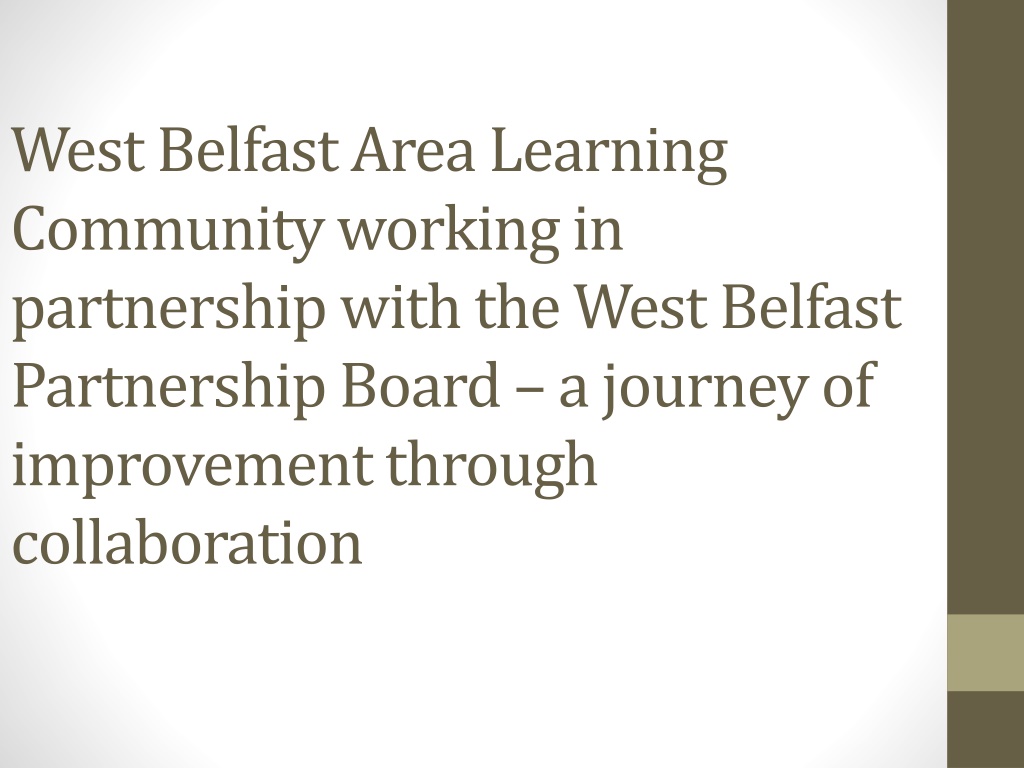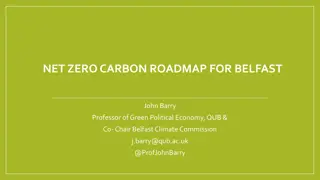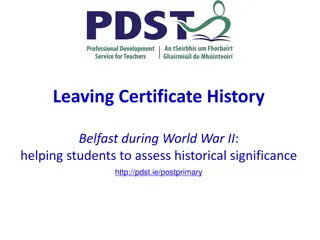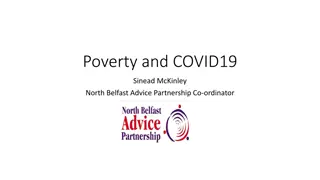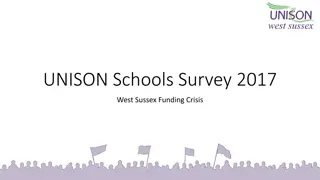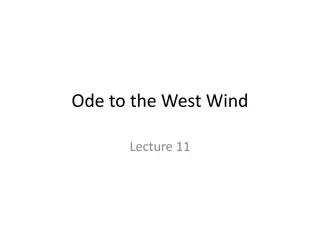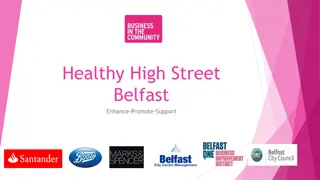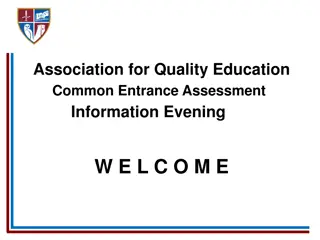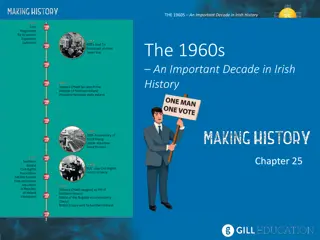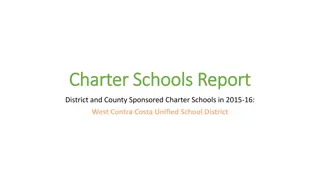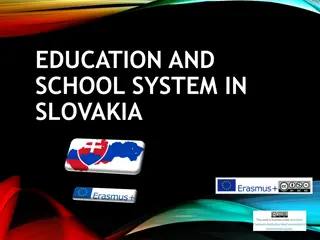A Decade of Collaboration and Transformation in West Belfast Schools
The West Belfast Area Learning Community and the West Belfast Partnership Board embarked on a journey of improvement through collaboration from 2007 to 2017. Initially facing challenges, schools transitioned from isolation to collaboration, driven by policy changes and the need for sustainable practices. The community, once fragmented, evolved into a network of schools working together to meet the needs of pupils and ensure quality education. Overcoming socio-economic factors, falling enrollments, and policy pressures, schools in West Belfast transformed into vibrant, self-improving entities embracing collaboration.
Download Presentation

Please find below an Image/Link to download the presentation.
The content on the website is provided AS IS for your information and personal use only. It may not be sold, licensed, or shared on other websites without obtaining consent from the author. Download presentation by click this link. If you encounter any issues during the download, it is possible that the publisher has removed the file from their server.
E N D
Presentation Transcript
West Belfast Area Learning Community working in partnership with the West Belfast Partnership Board a journey of improvement through collaboration
Context of Collaboration a journey from isolation to collaboration 2007 -2017 Initially, schools starting working together under duress - through a forced relationship incentivised by meagre funding Many factors were impacting on the schools in the area Working in silos with little knowledge or understanding of each other Falling enrolments leading to redundancies with schools in danger of closing or amalgamating Poor standards of achievement across many of the schools Multiple socio-economic factors Major policy changes in education which were putting pressure on the system
Policy changes which were most impacting on schools (1) Sustainable Schools Policy All schools would have to be a minimum size at least 100 pupils in each year group - a major challenge with falling birth rates and enrolments The Department is committed to a vision that ensures that every learner fulfils his or her full potential at each stage of development. This means that new opportunities for collaboration and sharing in education should be pursued Area Based Planning linked to this policy Reconfiguration of the schools estate all schools were under threat Entitlement Framework Policy All schools would have to offer 24 subjects to pupils at Key Stage 4 (age 15) and 27 subjects at Key Stage 5 (Post 16) A specific combination of subjects would have to be offered at each key stage - a major challenge as schools would have to change their curriculum and would have to offer access to pupils from other schools
Policy changes which were most impacting on schools (2) Every School a Good School Policy 2008 All schools performance would be measured rigorously against specific benchmarks Our vision is of schools as vibrant, self-improving, well-governed and effectively led communities of good practice, focusing not on institutions but on meeting the needs and aspirations of pupils through high quality learning, recognising the centrality of teaching Move towards working as a community of schools vs schools looking after and out for themselves
Context of schools in West Belfast 70% of areas of highest deprivation in North of Ireland are in West Belfast The areas of social deprivation ranked numbers 1,2 & 3 are in West Belfast Population @ 94,000 = 5.2% of the population Child Poverty: 41.1% 0-15yr olds NI average 22.1% Colin Glen (65.3%), Falls (59.1%) and Shankill (58.3%). Health: If you live in West Belfast you are likely to die 8 years earlier than a person in a more affluent area of Belfast Education: 2011- 49% of pupils in West Belfast achieved 5 or more GCSE exams, in 2016 West Belfast ALC schools this has increased to 66.4% - spectacular improvement. West Belfast has a vibrant, flourishing education network which includes 23 nursery, 17 primary and 10 post primary schools as well as community organisations.
Enrolment School Type % FSME % SEN Number with Statement St Dominic s Grammar School Girls 1034 Selective 28.6% 5.4% 16 St. Rose s High School - Girls 240 All ability 71.3% 44.5% 10 St. Louise s Comprehensive College - Girls 1420 All ability 59.6% 39.2% 34 Corpus Christi College - Boys 258 All ability 73.3% 54.6% 36 Colaiste Feirste Co-ed Irish Medium 646 All ability 64.7% 51.8% 22 Christian Brothers Secondary School - Boys 500 All ability 65.2% 57.8% 50 St. Mary s CBS Grammar School - Boys 1161 All ability 38.5% 19% 33 St. Gerard s School Co-ed 232 Special 76.3% 100% 224 -96.5%
Drivers which enabled progress true collaboration leading to improved pupil outcomes across West Belfast Area (1) 2009 Area-based inspection in West Belfast many areas of concern were raised A number of new agents began attending the West Belfast Area Learning Community The ETI District Inspector, Dr Shevlin and Ms Angie Mervyn, Education Officer of the West Belfast Partnership Board (umbrella group for numerous community groups) - facilitated through having an effective Chair and Co-ordinator (latter was financed through DE), the Belfast Education and Library Board Advisor for Post-primary Dr Shevlin focused all the schools on self-evaluation and self- improvement Angie Mervyn started channelling additional funding for literacy and numeracy into schools
Drivers which enabled progress true collaboration leading to improved pupil outcomes across West Belfast Area (2) Attention from outside the area Dublin City University West Belfast targeted for Polycentric Area- based improvement research Schools started building trusting relationships through working together to identify areas which required improvement across all schools and setting up self- improvement sub groups/teams CEAIG Careers team ICT team Pastoral team Numeracy team SEN Team Vice-principals team
Drivers which enabled progress true collaboration leading to improved pupil outcomes across West Belfast Area Practical activities arising from these Maths HoDs began meeting each other to share best practice and to visit schools where best practice was happening Additional resources in schools to promote Saturday Schools, after- schools support for pupils struggling with Maths and English Access to courses which met the needs and aspirations of pupils schools which could offer additional courses supported schools which couldn t offer a broad curriculum to their pupils Performance Data was collated from across the schools and schools started taking pride in the performance of the area vs focusing solely on their own data performance rose beyond expectation Careers Conference is arranged annually for pupils from all schools Joint training in leadership Sharing of best practice across all sub groups
Performance All Pupils GCSE Results 5 or more Grades A* - C including Maths & English 7 or more Grades A* - C including Maths & English 2015 2016 % increase 4.9% 2011 2016 % increase 17.4% 2.2% 15% A Level Results 2015 2016 % increase 2011 2016 % increase 2 or more Grades A* - E 3 or more Grades A* - C 1.9% 4.3% 6.1% 15.5%
Next Practice vs Best Practice Primary schools started replicating the work of post-primary group and in turn the nursery schools started doing likewise Primary Transition programme- bridging units planned for last year in primary school and first year in post-primary. Through working together and delivering a joint programme, the primary and post-primary schools are gaining a better understanding of each other s curriculum Cross-phase sharing of best practice including classroom observation and assessment practices
